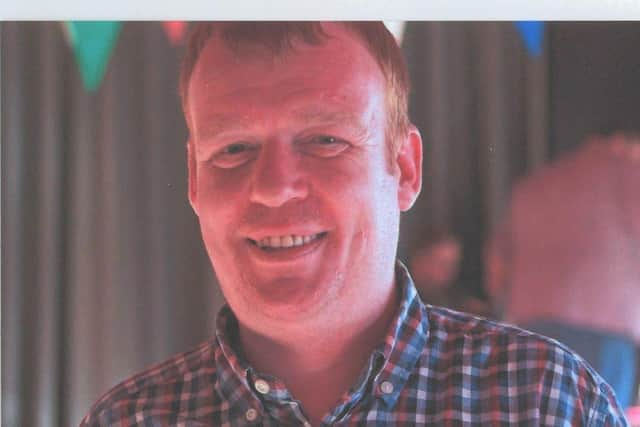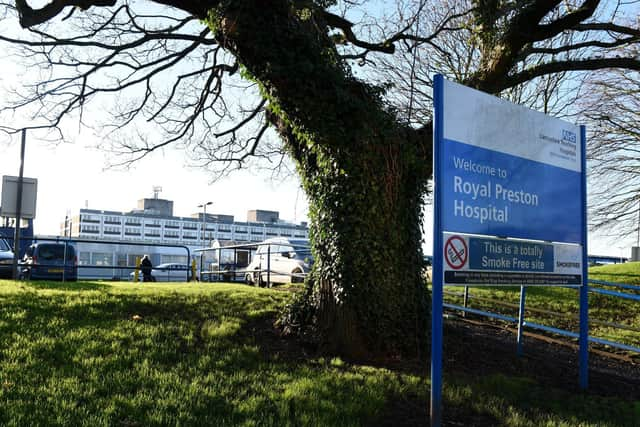Blood stained Nike trainers are shown to murder jury in which Blackpool man stamped on Garstang dad as he lay in the road
and live on Freeview channel 276
Matthew Pearson, 42, originally from Garstang, died at the Royal Preston Hospital on Sunday, August 2 following an assault on Lytham Road in Blackpool, close to the junction with Bournemouth Road at 6.45pm on Saturday, July 18 last year.
A post mortem examination found Mr Pearson, who lived in a flat on Lytham Road, died from blunt trauma head injuries.
Advertisement
Hide AdAdvertisement
Hide AdAndrew Claydon, 44, also of Lytham Road, denies his murder but admits his manslaughter - a lesser offence in law - and is on trial before Preston Crown Court.


The victim's blood was recovered from his trainers and the pair of black and white Nikes were shown to the jury this afternoon.
Helen Jones, a forensic scientist for Lancashire Constabulary, gave evidence to the court in which blood splatter was found on both trainers.
During a forensic examination, Mrs Jones said the trainers were examine under a microscope and blood spots and splashes were found on the 'upper toe area, the lace and the inner aspect' of the left trainer. She added that the inner aspect is the part of the trainer that is facing the other trainer.
Advertisement
Hide AdAdvertisement
Hide AdMrs Jones added that blood was visible to the naked eye on the left trainer on the 'upper and inner' areas.


She said: "There's no specific number but there would be estimated in excess of 30 to 40 spots [on the left trainer].
Adding: "The blood that was sampled, from the blood spot within the pattern indicated a mixed DNA profile, which indicated the DNA from more than one individual represented.
"I further understand that when a comparison was made to Matthew Pearson his DNA was represented within the mixture in such a way that he could have contributed a larger portion of the DNA detected."
Advertisement
Hide AdAdvertisement
Hide AdGordon Cole QC, prosecuting, asked Mrs Jones how the blood could have transferred onto the pair of trainers and the distance it would have travelled.
Mrs Jones said: "All we can do is put it in close proximity, we can't give a specific distance, but you could address it was closer to, maybe a few inches as opposed to six foot away but not as to where they were specifically stood.
"Given the circumstances you could address that the side of that shoe [left shoe] was facing more where the area had come from. For example, if the right foot had, if you imagine a puddle puddle, if the right shoe hits into the area of water for example, then the left shoe you would expect to find a lot more spots and splashes on the standing leg as opposed to the moving leg."
Earlier in the day, Dr Alison Armour, a consultant pathologist at the Royal Preston Hospital, gave evidence at the trial and said Mr Pearson had sustained an extradural haemorrhage, which is bleeding underneath the skull cap but on top of the dura, which covers the brain.
Advertisement
Hide AdAdvertisement
Hide AdShe said: "In an attempt to save Mr Pearson's life, the surgeon did what's called a craniotomy. In other words, he incised the bone, moved the bone and moved the haemorrhage underneath the bone, and then replaced the bone with metal sutures and then replaced the skin of the skull. So that was an attempt to save Mr Pearson's life."
Dr Armour also explained to the jury what injuries Mr Pearson had suffered during the assault and the likely cause of them.
She concluded: "In my opinion Mr Pearson died following a violent assault as a direct result of head injuries he sustained during this assault. This is known as blunt head trauma, which should ascribed as the cause of death in this case.
"This man [Mr Pearson] sustained a basal skull fracture, which is a fracture to the base of the skull itself with bleeding onto the surface of the brain, known as extradural haemorrhage. These injuries were caused as a result of a violent assault, where this man was thrown with considerable force to the ground and was then stamped on the right side of his head.
Advertisement
Hide AdAdvertisement
Hide Ad"The skull fracture results from a side impact, which could have been caused if this man's head struck the ground following the stamp on the head, or indeed as a combination of both.
"Whatever the actual mechanism of the force transmitted to this man's head it caused the skull to fracture and the bleed on the brain, which led to rapid unconsciousness at the scene and when Mr Pearson regained consciousness and was able to walk unaided back to his flat. This period of time is known as the lucid period and is seen in cases of extradural haemorrhage.
"However, the haemorrhage eventually bleeds to such an extent that within the skull the deterioration then occurs, leading to unconsciousness and ultimately the death of this man despite neurosurgical intervention.
"Death was therefore directly due to the injury sustained during the assault on July 18 and in my opinion the degree of force required to sustain such a basal skull fracture is considerable.
Advertisement
Hide AdAdvertisement
Hide Ad"Following the primary head injury this man developed secondary changes within the brain, which included contusions or bruising, swelling, ischemic hypoxic change, which is a lack of oxygen supplying the neurons to the brain, traumatic brain injury, which was identified by my colleague Dr du Plessis, and infarction of the brain itself, which meant the brain was undergoing death.
"It is my opinion that this man sustained a very serious and severe head injury which was responsible for his death."
Yesterday Gordon Cole QC, prosecuting, said the blow had fractured his skull and left him bleeding heavily.
Mr Pearson lay unconscious or around two and half minutes before a passer by attempted to help him and called an ambulance.
Advertisement
Hide AdAdvertisement
Hide AdThe court heard how Mr Claydon was heard at the time of the incident going towards Matthew Pearson and said "Watch this, f*** him".
Mr Cole added: "Having punched him he then in effect slammed him down onto the floor, and then followed that up with what is described as, and we say is clear from the footage, a forceful and violent stamp to the head of Matthew Pearson.
"It may well be as he was slammed to the floor he was unconscious very quickly but the stamp is, we submit, an important feature of this case."
Mr Pearson was eventually able to get up and go back to his flat, though bleeding was seen from his ear.
Advertisement
Hide AdAdvertisement
Hide AdHe was later treated for bleeding on his brain and a basal skull fracture.
Those injuries caused him to lose his life, which prosecutors say was a direct result of the attack
Mr Claydon was originally arrested on suspicion of wounding but rearrested for murder.
(Proceeding)
Thanks for reading. If you value what we do and are able to support us, a digital subscription is just £1 for your first month. Try us today by clicking here